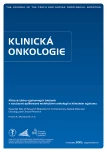Cancer in Adolescents
Authors:
V. Bajčiová; Z. Onderčová; D. Kodýtková
Authors‘ workplace:
Klinika dětské onkologie LF MU a FN Brno
Published in:
Klin Onkol 2015; 28(Supplementum 2): 81-90
doi:
https://doi.org/10.14735/amko20152S81
Overview
Cancer in adolescents (15 to 19 years) appears to be a serious medical, psychologic, ethical and economical problem as well. This group of patients has been languishing in the shadow of pediatric oncology and out of interest of adult oncology. Spectrum of types of tumors and their biologal characteristics are age‑ specific and different from all other age groups. The overall incidence of cancer in adolescents is continuously increasing. Treatment results and outcome of adolescent cancer are worse compared with outcome in children with cancer younger than 15 years.
Key words:
adolescents – cancer – age‑specific differences – diagnostic challenges – therapeutic options
This study was supported by the European Regional Development Fund and the State Budget of the Czech Republic – RECAMO, CZ.1.05./2.1.00/03.0101 and by the project MEYS – NPS I – LO1413.
The authors declare they have no potential conflicts of interest concerning drugs, products, orservices used in the study.
The Editorial Board declares that the manuscript met the ICMJE “uniform requirements” for biomedical papers.
Submitted:
17. 5. 2015
Accepted:
22. 7. 2015
Sources
1. Bajčiová V. Definice adolescentního věku. In: Bajčiová V, Tomášek J, Štěrba J. Nádory adolescentů a mladých dospělých. Praha: Grada 2011: 1– 2.
2. Bajčiová V. Adolescenti a mladí dospelí – „zabudnutá“ skupina v onkológii? Onkológia 2006; 1(2): 98– 102.
3. Aubin S. What should the age range be for AYA oncology? J Adol Young Adult Oncol 2011; 1(1): 3– 7.
4. Coccia PF, Altman J, Bhatia S et al. Adolescent and young adult oncology. Clinical practice guidelines in oncology. J Nat Compr Cancer Netw 2012; 10(9): 1112– 1150.
5. Pearce MS, Parker L, Windebank KP et al. Cancer in adolescents and young adults aged 15– 24 years: a report from the North of England young person’s malignant disease registry, UK. Pediatr Blood Cancer 2005; 45(5): 687– 693.
6. Bleyer WA. Cancer in older adolescents and young adults: epidemiology, diagnosis, treatment, survival and importance of clinical trials. Med Ped Oncol 2002; 38(1): 1– 10.
7. Pentheroudakis G, Pavlidis N. Juvenile cancer: improving care for adolescents and young adults within the frame of medical oncology. Ann Oncology 2005; 16(2): 181– 188.
8. Albritton K, Bleyer WA. The management of cancer in the older adolescent. Eur J Cancer 2003; 39(18): 2584– 2599.
9. Bajčiová V. Epidemiologie nádorů u dospívajících a mladých dospělých. In: Bajčiová V, Tomášek J, Štěrba J. Nádory adolescentů a mladých dospělých. Praha: Grada 2011: 7– 22.
10. Bleyer WA. Young adult oncology: the patients and their survival challenges. CA Cancer J Clin 2007; 57(4): 242– 255.
11. Freyer DR, Felgenhauer J, Perentesis J et al. Children΄s oncology grou’s 2013 blueprint for research: adolescent and young adult oncology. Ped Blood Cancer 2013; 60(6): 1055– 1058. doi: 10.1002/ pbc.24431.
12. Vassal G, Fitzgerald E, Schrappe M et al. Challenges for children and adolescents with cancer in Europe: the SIOP‑ Europe agenda. Pediatr Blood Cancer 2014; 61(9):1551– 1557. doi: 10.1002/ pbc.25044.
13. Veal GJ, Hartford CHM, Stewart CF. Clinical pharmacology in the adolescent oncology patient. J Clin Oncol 2010; 28(32): 4790– 4799. doi: 10.1200/ JCO.2010.28.3473.
14. Dang‑ Tan T, Franco EL. Diagnostic delay in childhood cancer: a review. Cancer 2007; 110(4): 703– 713.
15. Bajčiová V. Rizika a následky pozdní diagnózy u dospívajících. Vox Pediatriae 2012; 12(6): 26– 29.
16. Ahrensberg JM, Fenger‑ Grøn M, Vedsted P. Use of primary care during the year before childhood cancer diagnosis: a nationwide population – based-matched comparative study. PLoS One 2013; 8(3): e59098. doi: 10.1371/ journal.pone.0059098.
17. Fern LA, Campbell CH, Eden TO et al. How frequently do young people with potential cancer symptoms present in primary care? Brit J Gener Pract 2011; 61(586): 223– 230. doi: 10.3399/ bjgp11X572418.
18. Hayes‑ Lattin B, Mathews‑ Bradshaw B, Siegel S. Adolescent and young adult oncology training for health professionals: a position statement. J Clin Oncol 2010; 28(32): 4858– 4861. doi: 10.1200/ JCO.2010.30.5508.
19. Schiffman JD, Geller JI, Mundt E et al. Update of pediatric cancer predisposition syndromes. Ped Blood Cancer 2013; 60(8): 1247– 1252. doi: 10.1002/ pbc.24555.
20. American Society of Clinical Oncology. American Society of Clinical Oncology policy statement update: genetic testing for cancer suspectibility. J Clin Oncol 2003; 21(12): 2397– 2406.
21. Meadows AT, Friedman DL, Neglia JP et al. Second neoplazma in survivors of childhood cancer: findings from the Childhood Cancor Survivor Study cohort. J Clin Oncol 2009; 27(14): 2356– 2362. doi: 10.1200/ JCO.2008.21.1920.
22. Freyer DR. Transitional of care for young adult survivors of childhood and adolescent cancer: rationale and approaches. J Clin Oncol 2010; 28(32): 4810– 4818. doi: 10.1200/ JCO.2009.23.4278.
23. Sender LS. The AYA cancer patientś survivorship: challenges and opportunities. J Adol Young Adult Oncol 2013; 2(3): 87– 88.
24. Zahara R, Rosenberg‑ Yunger S, Klassen AF et al. Barriers and facilitators of transition from pediatric to adult long‑term follow up care in childhood cancer survivors. J Adol Young Adult Oncol 2013; 2(3): 104– 111.
25. Fernandes SM, O΄Sullivan‑ Oliviera J, Landzberg MJet al. Transition and transfer of adolescents and young adults with pediatric onset chronic disease: the patient and parent perspective. J Pediatr Rehabil Med 2014; 7(1): 43– 51. doi: 10.3233/ PRM‑ 140269.
26. Tayc.org [homepage on the Internet]. Teenagers and young adults with cancer. Available from: www.tyac.org.uk.
Labels
Paediatric clinical oncology Surgery Clinical oncologyArticle was published in
Clinical Oncology

2015 Issue Supplementum 2
Most read in this issue
- Adenoviral Vectors in Gene Therapy
- Nrf2 – Two Faces of Antioxidant System Regulation
- Recombinant Antibodies and Their Employment in Cancer Therapy
- What Can Study of Oligomerization of Proteinsin the Process of Oncogenesis Bring Us?
